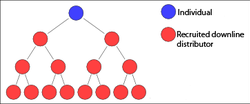A binary plan is an organizational structure used in multi-level marketing (MLM) organizations. In this structure, new members are introduced into a system with a tree-like structure where each “node” or new member of the organization has a left and right sub-tree.[citation needed] Binary plans began to be introduced by MLM companies in the late 1980s and became one of the four most common organizational structures by the early 2000s.[citation needed]
Structure[edit]
In each sub-tree of a binary plan, there is the outside (power) leg and the inside (profit) leg.[citation needed] Under the power leg, new distributors are always placed underneath their recruiter, typically in the next available node when the recruiter does not have any direct leaf nodes left.[citation needed] This contrasts with the profit leg which is typically filled with members who are directly sponsored or enrolled by their immediate ancestor.[citation needed]
Another element of a binary plan is that it makes each member only responsible for recruiting and sponsoring two others to join the plan,[citation needed] which can potentially lead to rapid expansion, with potentially unlimited members.[citation needed] However, if a recruiter successfully recruits more than two people, they are added to the next available node in the power leg.[citation needed] This allows for the profits from gaining a new member to be shared between all ancestors in the power leg, regardless of who recruited them, in a process known as spillover.[citation needed]
Compensation[edit]
Whichever sub-tree makes the least amount of money becomes the “pay leg” due to a concept known as balanced volume, which is typically used in MLM binary compensation plans.[citation needed] The members of both sub-trees are paid a percentage of the pay leg’s growth regardless of how much growth that person is responsible for or which tree that person is actually in.[citation needed] This leaves the difference between the more profitable and the pay leg of the binary plan to be left over and not paid out, in a process known as flushing.[citation needed] Recruiters tend to introduce new distributors into their pay legs to try to minimize the difference between the more profitable and the pay leg.[citation needed] This process is called balancing the legs and is difficult to do as one person's power leg benefits from spillover from child members while their profit leg does not.[citation needed] This makes it important to maximize the profit from the profit leg, which is done solely by the individual.[citation needed] To fix this, some companies weaken "power legs" via policies such as requiring distributors to place one member into both of legs before being eligible to receive commission.
Legal issues[edit]
Binary plans work under the same logic as other MLM operations under the law, meaning that it is subject to four main areas of law governing the multilevel marketing industry, namely:[citation needed][improper synthesis?]
- Anti-Pyramid Laws. To be classified as not a pyramid scheme, which are illegal to operate, binary plans must give compensation based upon legitimate sales versus giving compensation for recruiting other members alone. A legitimate product or service must be given by the company to be able to continue.[1][not in citation given]
- Business Opportunity Laws. Depending on the jurisdiction, the company with a binary plan must file an annual or bi-annual report on their operations to the correct government office detailing the program, its finances and the identities and information about the promoters and the distributors of the organization.[2][need quotation to verify]
- Securities Laws. To avoid designations as an illegal security known as an investment contract,[1][not in citation given] the recruiters of a binary plan must not lead potential members to believe that profits will come from the recruiter or some other third party.[2][need quotation to verify]
- Lottery Laws. Similar to security laws, the recruiters and promoters of a binary plan must not imply that profits are determined by chance as opposed to the skill of the potential new member or the people in the organization.[2][need quotation to verify] To do this, organizations run under a binary plan often have mandatory participation in sales, marketing and management efforts.[citation needed]
See also[edit]
References[edit]
- ^ a b "AG - Multi-Level Marketing or Illegal Pyramid Scheme?". www.michigan.gov. Retrieved 2015-10-27.
- ^ a b c Sherman, Andrew (2011). Franchising & Licensing: Two Powerful Ways to Grow Your Business in Any Economy. New York: AMACOM. pp. 364–368. ISBN 9780814415566.
'TERM' 카테고리의 다른 글
| Process Vs. Thread | Difference Between Process and Thread (31) | 2023.09.01 |
|---|---|
| [운영체제/OS] 프로세스와 컨텍스트 스위칭(Context Switching) (1) | 2023.09.01 |
| Engineering, procurement, and construction (EPC) (31) | 2019.01.29 |
